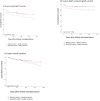Comparison of kidney allograft survival in the Eurotransplant senior program after changing the allocation criteria in 2010-A single center experience
- PMID: 32702005
- PMCID: PMC7377418
- DOI: 10.1371/journal.pone.0235680
Comparison of kidney allograft survival in the Eurotransplant senior program after changing the allocation criteria in 2010-A single center experience
Abstract
Aims: The European Senior Program (ESP) aims to avoid waiting list competition between younger and elderly patients applying for renal transplantation. By listing patients ≥65 years on a separate waiting list and locally allocating of grafts ≥65 years exclusively to this cohort, waiting and cold ischemia times are predicted to be shortened, potentially resulting in improved kidney transplantation outcomes. This study compared a historic cohort of renal transplant recipients being simultaneously listed on the general and the ESP waiting lists with a collective exclusively listed on the ESP list in terms of surrogates of the transplantation outcome.
Methods: Total 151 eligible patients ≥ 65 years from Münster transplant Center, Germany, between 1999 and 2014 were included. Graft function, graft and patient survival were compared using surrogate markers of short- and long-term graft function. Patients were grouped according to their time of transplantation.
Results: Recipients and donors in the newESP (nESP) cohort were significantly older (69.6 ± 3.5 years vs 67.1 ± 2 years, p<0.05; 72.0 ± 5.0 years vs 70.3 ± 5.0 years, p = 0.039), had significantly shorter dialysis vintage (19.6 ± 21.7 months vs 60.2 ± 28.1 months, p<0.001) and suffered from significantly more comorbidities (2.2 ± 0.9 vs 1.8 ± 0.8, p = 0.009) than the historic cohort (HC). Five-year death-censored graft survival was better than in the HC, but 5-year graft and patient survival were better in the ESP cohort. After 2005, cold ischemia time between groups was comparable. nESP grafts showed more primary function and significantly better long-term graft function 18 months after transplantation and onwards.
Conclusion: nESP recipients received significantly older grafts, but experienced significantly shorter time on dialysis. Cold ischemia times were comparable, but graft function in the nESP cohort was significantly better in the long term.
Conflict of interest statement
The authors have declared that no competing interests exist.
Figures


References
-
- Ponticelli C PM, Graziani G. Renal transplantation in elderly patients. How to select the candidates to the waiting list? Transpl Rev. 2014;28(4):188–92. - PubMed
-
- Tonelli M, Wiebe N, Knoll G, Bello A, Browne S, Jadhav D, et al. Systematic review: kidney transplantation compared with dialysis in clinically relevant outcomes. American journal of transplantation: official journal of the American Society of Transplantation and the American Society of Transplant Surgeons. 2011;11(10):2093–109. - PubMed
-
- Lehner LJ SO, Halleck F, Liefeldt L, Bamoulid J, Budde K. Need for optimized immunosuppression in elderly kidney transplant recipients. Transplantation Reviews. 2015;2015:237–9. - PubMed
Publication types
MeSH terms
Substances
LinkOut - more resources
Full Text Sources
Medical

